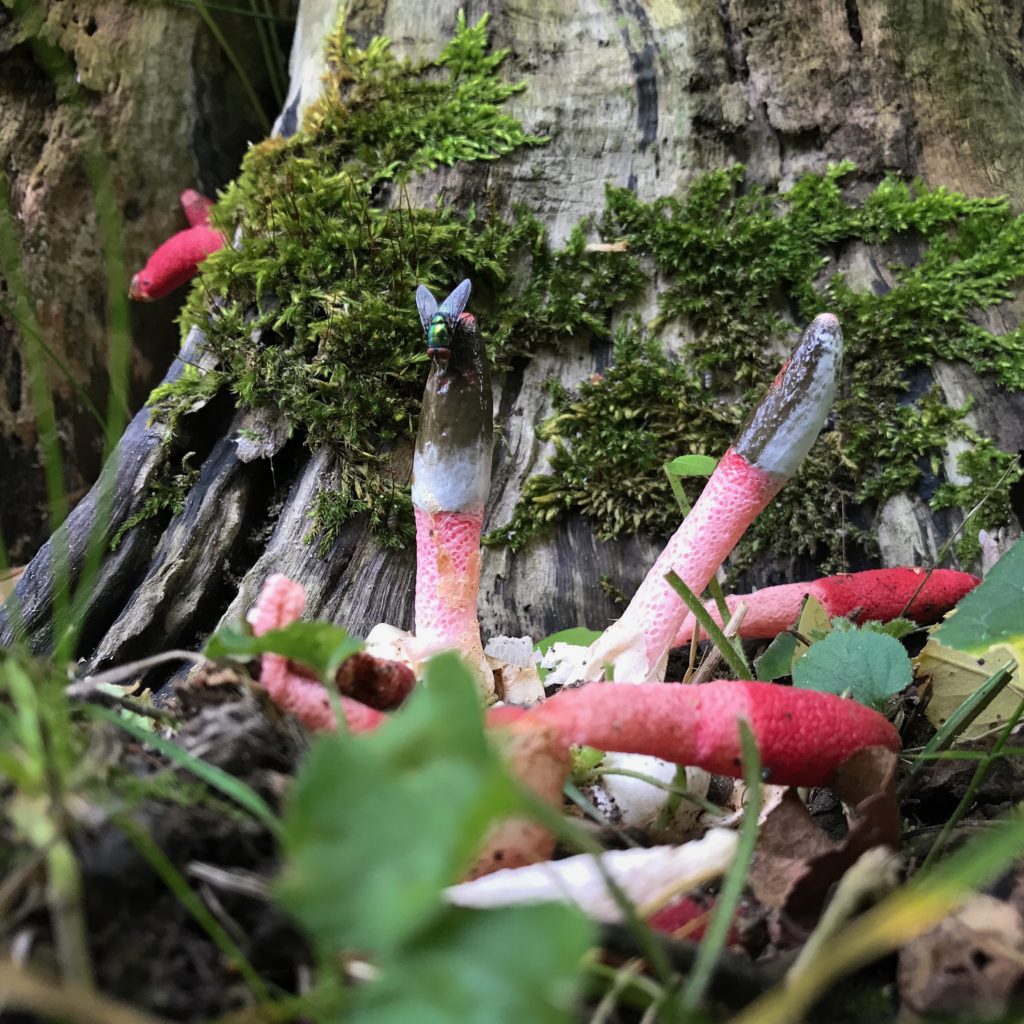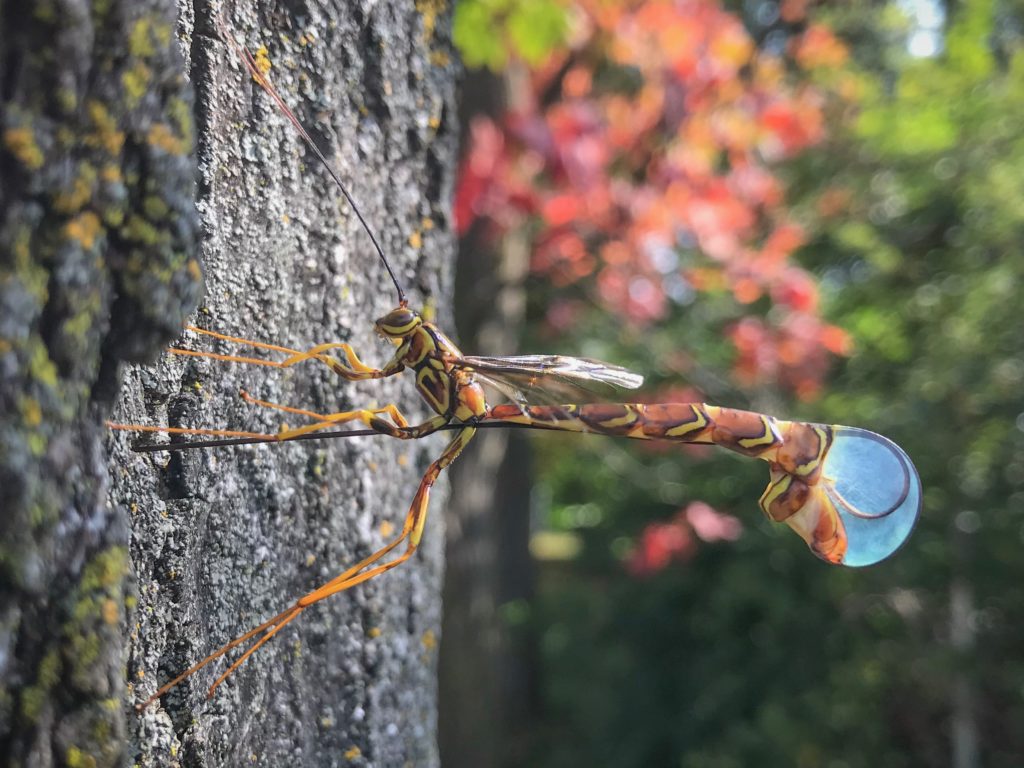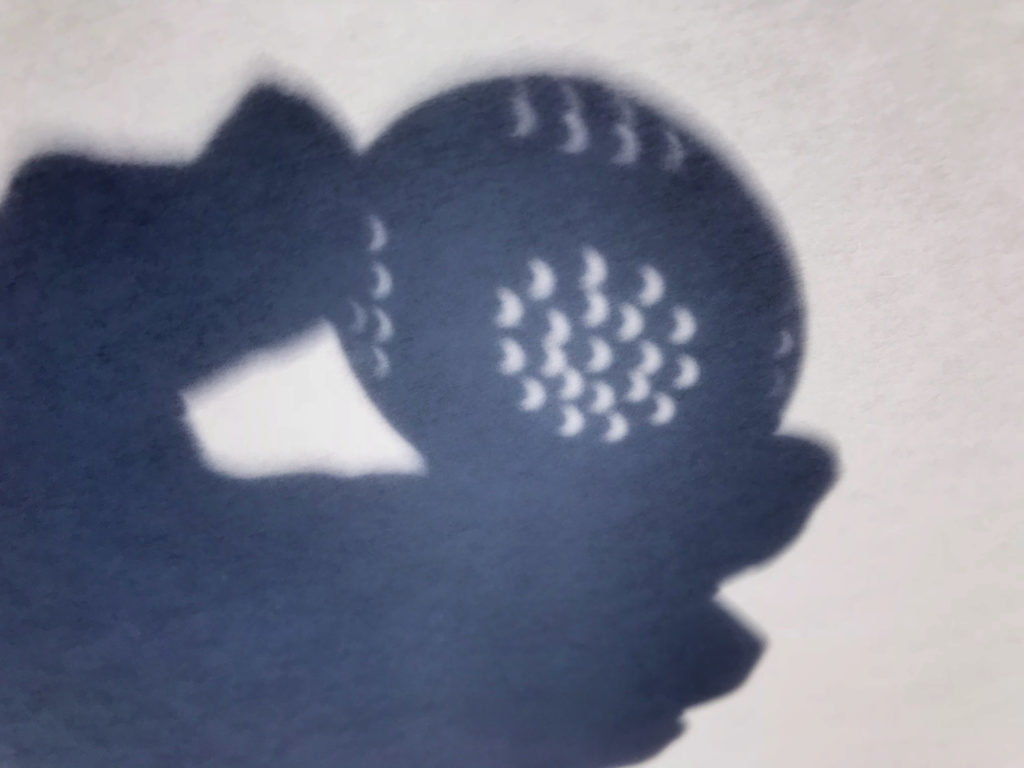Marvellous stretch of weather, eh? After such a long lush wet growing season, we’re finally having a true Southern Ontario summer that’s straddling the astronomical boundary between Summer and Fall.
Highlights of my natural history this summer include the amazing diversity and beauty of fungi produced on one old poplar stump right in by backyard! On a twenty-year-old stump that’s only ever had Dryad’s Saddle, Polyporus squamosus, suddenly beginning in the middle of July and continuing to the present, I’ve had a succession of amazing finds, only one of which I’ve ever seen before! The surprises began with the brilliant yellow Creeping Dog-vomit Slime Mold, Fuligo septica — which is the one find I’ve actually had before in my yard. (It’s actually a slime mold, not even related to fungi, but I hope you’ll excuse my sloppy phylogeny …) Then came a large brownish brown-spored gilled fungus that I’ve not been able to identify, along with a small ephemeral pale brown gilled fungus, also unidentified.

Elegant Stinkhorn, Mutinus elegans, with Greenbottle Fly
One morning in late July I noticed something scarlet red appearing around the base of the stump. I was able to immediately recognize it as a Stinkhorn, and then more precisely identify it as Mutinus elegans, Elegant Stinkhorn, on the basis of the crimson tip and the brownish-green slime at the tip. At first, one Stinkhorn would come up, and within two days would collapse, only to be followed by another. Then, as many as six would erupt at once. Two months later, I’m still getting days with three or four fruiting at the same time. The fungus appears first in a white ‘egg’ at the surface of the ground, sometimes taking weeks to slowly break free of the white covering which forms a volva cup at the base of the stalk. In due time, the actual stalk and the crimson tip appear literally overnight — within 10 hours! The stalk is beautifully lacy and reticulate, clearly the result of a quick uptake of water to expand the cells that preform in the ‘egg’. The top of the stack appears with the stinky foetid browny-green slime that smells of a combination of rotting salmon and faeces! In the morning, various flies cover the slime, eating it off within several hours, exposing the brilliant crimson tip. The spores of this basidiomycete fungus are in the slime. Thus the flies spread the spores around as they clamber across other rotting wood. I’ve seen at least six species of flies, ranging from Greenbottles, and Bluebottles, and Cluster flies, to various smallish muscid flies like small House Flies, and even Fruit Flies on the slime. Yet another interesting fact is that Stinkhorns seem to be the first fungi described by Europeans in North America, by the British missionary John Bannister in 1679. (I wonder what he made of the striking phallic shape. Perhaps that’s where one of the alternate names of Devil’s Dipstick comes from …)
There have since been at least two other species of mushroom appeared on this stump, including another small unidentified brown-spored basidiomycete. The largest of the summer’s mushrooms has been the striking large cinnamon-coloured Laughing Cap mushroom, Gymnopilus spectabilis. It’s a beauty in its own right, but is definitely eclipsed by the Elegant Stinkhorn in photographic beauty. I’ve no idea where the ‘laughing’ comes from, other than that to most people, the mushroom is poisonous and perhaps hallucingenic, since some strains contain psylocybin. The Korean name translates to bronze clown mushroom.
It seems to me that all of these mushrooms must specialize in the late-stage decay of dead wood. The most difficult of the lignin components of wood are what remains after the 20 years of decay of this poplar stump. Combined with the extreme wetness of this summer, this particular stump has crumbled to the point where I can crush the remaining wood with my bare hands, sometimes squeezing water out of pieces of it.

Ichneumonid Megarhyssa wasp parasitic on horntail wasps in sugar maple tree
Perhaps the other most exciting observation of the summer is also associated with late stages of rotting wood. Just a week ago, I noticed an ichneumonid wasp laying eggs on a dying maple tree on our neighbour’s property along our fence line. These fascinating beauties are often portrayed in introductory entomology books, but I’ve never seen one alive. I’ve since seen at least five on this one tree! (I will show several videos at our upcoming Members’ Night on Tuesday October 25th.) Briefly, this wasp is almost 15 cm long, from the tip of its slender antennae, to the end of the almost 10 cm long ovipositor and sheath. The body alone of this wasp is 5 cm! Various Megarhyssa species live in our area, all of specializing as parasitoids of another wasp, the Horntail Pigeon Wasp, Tremex columba — which I have seen in years past on our property! The female pictured here took over 30 minutes to probe around with her ovipositor, repeatedly pushing it into the softened white-rotted wood inside the sugar maple to search out the Horntail larvae on which to lay her eggs. The Horntail wasp lays her eggs on dead wood and includes spores from a specific fungus which lives on dead wood. The developing Horntail larvae feed on the fungus. Along comes the ichneumon wasps and lays her eggs on the Horntail. The ichneumon larvae live externally on the parasitized larvae, eating them from the outside but leaving the most critical components of the Horntail alive until the the ichneumon is ready to pupate!

Here’s another sighting from our backyard this summer. Can you guess how these particular shapes were formed?
